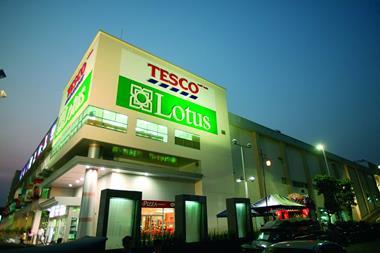As Tesco reports a 13% fall in full-year group trading profit, Retail Week looks at what has been a turbulent year for the UK’s largest retailer.

April 2012
– Chief executive Philip Clarke unveiled his Building a Better Tesco strategy to invest £1bn over three years to improve customer experience in UK stores. Full-year year like-for-likes slipped 0.9%. The retailer put its £110m advertising account under review as it looked to revamp its image, and it revealed it is to dump its Tesco Value range after nearly 20 years launching Everyday Value in the process.

May 2012
– Clarke told senior store managers he will cut bonuses by more than 80% while he himself declined his annual bonus after the grocer’s poor performance in the UK. Clarke was in line to receive £372,000, 13.5% of the maximum bonus possible under the performance linked scheme.

June 2012
- Tesco described its first quarter performance as “robust” after reporting a 1.5% fall in UK like-for-like sales, slightly better than the 1.6% decrease in the previous quarter but still its fourth consecutive quarter of like-for-like decline. The grocer also revealed its exit plan of its loss-making Japanese business in two stages, the first of which involved selling 50% of the operation to Japan’s largest retailer Aeon for a “nominal sum”. It also purchased a stake in digital music platform WE7 for £10.8m.

July 2012
– Brokers JP Morgan Cazenove and Nomura cut their forecasts for pre-tax profits after changes to regulations in South Korea restricted trading in the grocer’s largest market outside the UK. Job cuts at US venture Fresh & Easy’s head office emerged amid questions over its performance. However, in a positive move, Tesco hired US advertising giant Wieden + Kennedy to revamp its marketing activities.

August 2012
– Tesco opened some of its stores for 24 hours on Sundays as rules over trading hours were relaxed during the Olympics. Nielsen data revealed the first signs of a recovery with Tesco outstripping Asda in terms of sales growth the previous month. Retail Week revealed the grocer had taken a minority stake in premium coffee shop chain Harris + Hoole.

September 2012
– Clarke heralds a digital revolution in retail and proclaimed that “apps are the new high street” at the World Retail Congress. A potential relaxation in foreign direct investment law in India offered positive news for Tesco which currently runs franchise stores in country.

October 2012
– Tesco revealed pre-tax profits for the 26 weeks to August 25 fell 11.6% on the previous year but stemmed the tide of 18 months of consecutive like-for-like decline, reporting an upturn of 0.1% excluding fuel and VAT in the second quarter. Clarke said: “We want to start a new chapter in the history of the company.”

November 2012
– Non-food boss Terry Price exited the business as Ocado non-food boss Simon Belsham rejoined Tesco after an 18-month absence. Rival Sainsbury’s outstripped Tesco’s first half performance, reporting an underlying first-half profit increase of 5.4% to £373m.

December 2012 – Clarke hired Greenhill to conduct a strategic review of its US Fresh & Easy business with an exit looking likely as group deputy chief executive Tim Mason exited the business. Industry data suggests Sainsbury’s and Tesco have the momentum heading into the crucial Christmas period.

January 2013 – Tesco reported a 1.8% increase in like-for-likes over Christmas as it enjoyed its busiest ever week for UK online sales. It also unveiled UK chief operating officer Chris Bush as its new UK managing director. House of Fraser’s Robin Terrell was unveiled as Tesco’s new multichannel director. Clarke apologised as Tesco founf itself at the centre of the horse meat scandal after its value burgers were found to contain horse DNA.

February 2013
– As the horse meat scandal escalated Tesco delisted Silvercrest – one of the suppliers at the heart of the scandal – and vowed to begin DNA testing its products, tighten its supply chain and begin sourcing more meat from the UK.

March 2013
– Tesco apologised after further horse meat is found in a meatloaf line. The retailer invested £48.6m in acquiring family restaurant chain Giraffe. It decided to suspend a trial of an exclusive organic vegetable box scheme after IT problems.

April 2013
– The grocer reports a 13% fall in group trading profit in the year to February 23 while group sales climbed 1.3% to £72.3bn. Clarke confirmed US exit taking a £1.2bn writedown.
Tesco profits down 13% and sales up 1.3% as it confirms US exit
- 1
- 2
- 3
 Currently reading
Currently readingTimeline: The highs and lows of Tesco's year
- 4
- 5
- 6






























No comments yet